Mount Green Spaces
11/22/2023
Photovoice Project Showcases Student Perceptions of Social Change
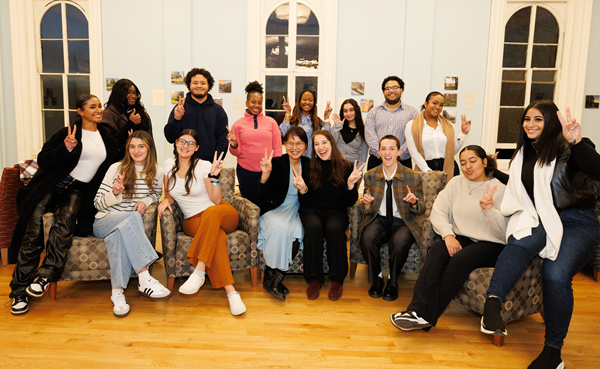
Students in Associate Professor of Psychology Jennifer Pipitone’s Environmental Psychology course and Associate Professor of Sociology LinDa Saphan’s Urban Planning course recently came together to launch a photovoice exhibit titled “Mount Green Spaces.”
The event, which held its opening reception on Monday, November 20, showcased student projects focused on identifying and improving green spaces around the Mount’s 70-acre campus of rolling hills and steep cliffs.
Research suggests that green spaces on college campuses have multiple benefits for students, ranging from increasing health and well-being to decreasing stress, and even serving as learning spaces. The “Mount Green Spaces” exhibition shares Mount students’ experiences with green spaces on campus, as well as ideas for how to improve them using photovoice.
What exactly is photovoice, you may be asking?
Photovoice is a participatory action research method based on health-promotion principles. The photo- component puts cameras in the hands of people to photograph their everyday realities; while the -voice component invites critical oral and written dialogue about the photographs.
“Integrating photovoice into our classrooms this semester allowed Dr. Saphan and I to teach students about the many health benefits of green spaces by meaningfully engaging them with the campus environment, which makes it more personally relevant for them,” noted Dr. Pipitone.
Through this project, students in both courses discussed and analyzed photographs in groups during an in-class workshop before selecting the final photos that appear in the exhibit. Notably, with photovoice, photos are less about how “artistic” they are, but rather, the stories they tell about the community.
“Photo exhibitions, like the ‘Mount Green Spaces’ exhibit, are often the ‘action’ component of photovoice projects,” Dr. Pipitone continued. “While the exhibition is meant to reach policy makers—in the case of this project, the Mount Saint Vincent administration—project success is not measured by whether or not changes are made. Rather, the goal is to empower students to become future advocates for social change in their own lives and communities during the project, and beyond.”
Additionally, through the “Mount Green Spaces” project, class participants also hope that their exhibit will encourage the larger Mount community to reflect on their own relationship with green spaces on campus, and perhaps even in their off-campus lives.
Take it from two students who participated in the project: Brooke Frierson ’25 and Samantha Yaker ’25.
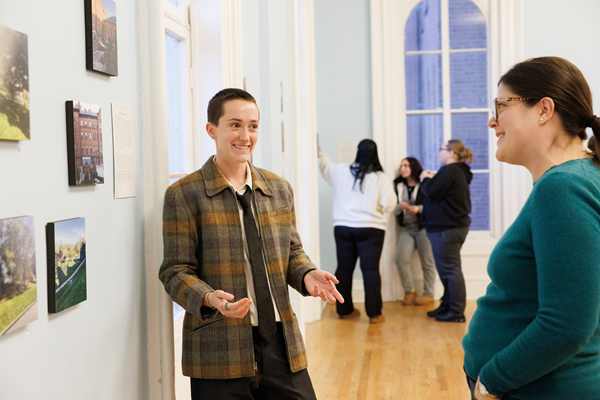
Brooke is a psychology major with a double minor in urban studies and studio art. They originally hail from Harker Heights, TX. Brooke shares:
“This project has been extremely insightful and has given me different perspectives in all the different fields I am interested in, such as urban planning, psychology, and photography—all of which I hope to gain more experience, knowledge, and opportunities in the near future. I am extremely grateful for the research opportunity and Mount Green Spaces exhibition, as it has been a way for me—as a passionate member of the Mount community—to strive to make a difference; particularly with the planning and designing of our green spaces.”
Brooke went on to continue to describe how they used the photovoice project as a way for them to objectively and empirically observe all the green spaces on campus. As a student who cherishes the beautiful campus that is Mount Saint Vincent, they think there are a few ways our green spaces can be improved for current students, future students, alumnae/i, faculty, and staff. This includes, but is not limited to, adding more seating, native plants, perhaps a fountain in the courtyard by Aquino Hall, or even a basketball court off to the side on the Great Lawn.
Brooke pondered: “The question is, how can we preserve these green spaces, well as well as gear them towards the collaboration of Mount community members?”
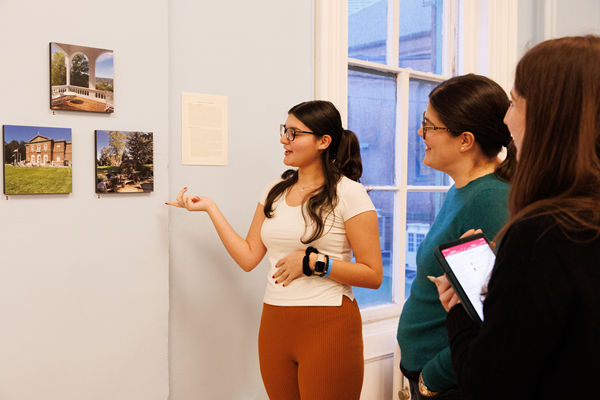
Samantha, originally from Ronkonkoma, NY, is an honors student majoring in psychology and a minor in general science. She mentions:
“The photovoice project dives into the connection between individuals and nature within the campus environment, which is meaningful to me because it allows me to express my feelings towards green spaces and how to improve them. Engaging in this project has provided me with a newfound understanding of the role these and all green spaces play in life. They serve as an escape, as not only an area for physical activities, but also as a platform for creative expression, whether through physical activity or moments of relaxation and conversation.”
Samantha states that it is now more apparent to her the significance of green spaces in promoting mental health, especially in the context of the stressors associated with college life.
Dr. Pipitone and Dr. Saphan are, of course, proud of Brooke, Samantha, and all the students who engaged in the “Mount Green Spaces” exhibit.
“This project allowed us to see our students and campus on a new light: the poetry expressed by our students through these photographs was moving as many places were shot from an angle we have never seen before,” said Dr. Saphan. “More than proud, we are grateful to our students for giving us a glimpse into their inner thoughts.”
Once the exhibition is concluded, Dr. Pipitone’s People in Places (PiP) Research Lab will be analyzing the data throughout the Spring. Stay tuned for more information to come after the New Year!
The exhibit ran through Wednesday, November 29 in the Blue Room on the second floor of Founders Hall. It was presented by the environmental studies and urban studies minor programs, as well as the Office of the Provost. Below, check out examples of the images on display—one from Brooke and one from Samantha!
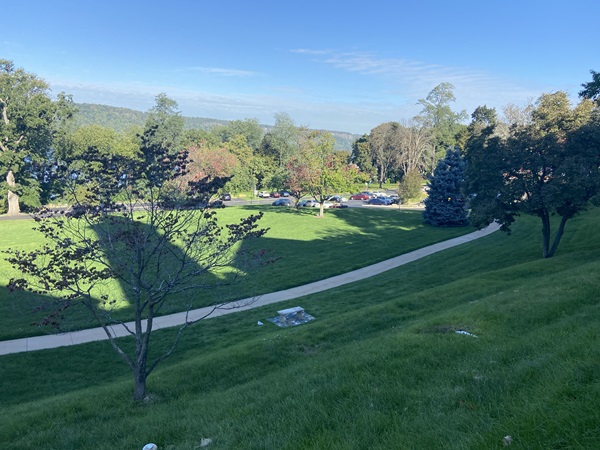
This photo was captured on the steps in front of Founders Hall. It captures a green hill and grass area featuring trees and a beautiful landscape with one bench for sitting. This green space is seldom used by students and faculty and is often a space only perceived by people. Is there something uninviting about this space? Is it the singular bench that makes people feel reluctant to use it? Perhaps the shadows in the cast by Founders Hall? Would this space be used differently if there were different varieties of seating? Arguably, I think it would be. The strength of this space remains in the vast amount of green space provided; however, it is less frequently used. With more seats and welcoming activities, the Great Lawn could be an inviting, engaging, and participatory space.
— Brooke Frierson ’25
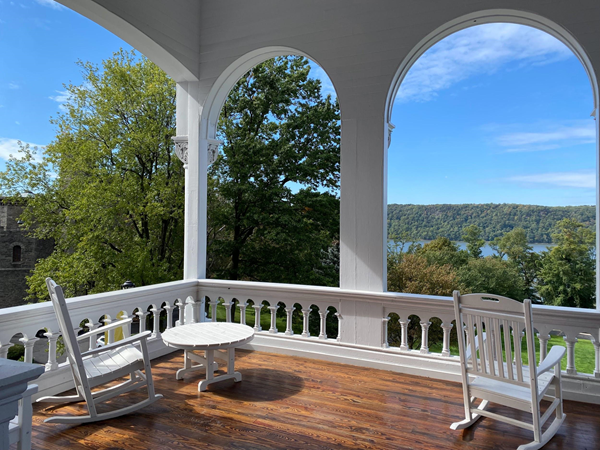
This captivating photo showcases the Founders Hall second floor balcony, offering a serene escape with two thoughtfully placed rocking chairs overlooking a historic castle through the trees. Beyond, the Great Lawn leads to the Hudson River. The arches beautifully frame the view, offering a soothing escape with a clear, sunny sky. The area, though unoccupied in the picture, serves as a flexible space: the movable chairs allow for social or solitary moments. It’s an ideal spot for relaxation, however many people don’t use it. The area might be undiscovered because of busy schedules or lack of awareness. To enhance accessibility, adding a ramp for individuals with disabilities could help. Expanding seating and space without compromising comfort ensures everyone can enjoy it, whether for socializing or solitude. The addition of higher tables could make it more functional for work or dining.
— Samantha Yaker ’25
About the University of Mount Saint Vincent
Founded in 1847 by the Sisters of Charity, the University of Mount Saint Vincent offers nationally recognized liberal arts education and a select array of professional fields of study on a landmark campus overlooking the Hudson River. Committed to the education of the whole person, and enriched by the unparalleled cultural, educational and career opportunities of New York City, the College equips students with the knowledge, skills and experiences necessary for lives of achievement, professional accomplishment and leadership in the 21st century.
